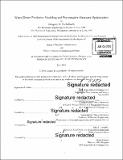Wires-down predictive modeling and preventative measures optimization
Author(s)
Eschelbach, Gregory D
DownloadFull printable version (5.334Mb)
Other Contributors
Leaders for Global Operations Program.
Advisor
Georgia Perakis and James Kirtley.
Terms of use
Metadata
Show full item recordAbstract
In 2012, the Pacific Gas and Electric Company (PG&E) identified overhead wires-down failure events as an important metric for safety and reliability. These events occur when power lines contact the ground and are caused by a host of reasons including trees falling on wires, animals creating problems, car accidents into poles, or older assets deteriorating and separating. To mitigate these wires-down events, PG&E has a portfolio of preventative measures including tree trimming, routine inspections, and replacement of older assets. This thesis hypothesized that a statistical approach could be used to identify the key drivers in wires-down events and predict future failure locations, thereby helping to direct the preventative measures. In the data aggregation phase of the project, ten datasets describing potential causal factors in wires-down events were integrated into a single database. Key contributions included utilizing clustering analysis to create standardized weather "environments" based on numerous weather factors, and developing an algorithm that used millions of individual tree trimming records to describe the vegetation environment surrounding each line segment. Statistical regressions and machine learning algorithms were then applied to the dataset to model the wires-down events. Out-of-sampling testing determined the best approach, and the predicted timeframe was iteratively rotated to show robustness throughout time. The best results were achieved using logistic regression models. These models predicted hot spot locations of future failures for specific failure modes and provided insight into the key factors that were causing the failures. To implement the models' findings, the discrete line segment failure probabilities were aggregated into sections of line that were several miles in length to calculate cumulative failure ratings. These groupings were the appropriate length for preventative measure projects at PG&E, and allowed PG&E to prioritize their tree trimming and re-conductoring efforts based on the future failure risk. Ultimately, this project simplified decision-making for PG&E experts by focusing their efforts onto a more manageable and perceivable portion of their complex network.
Description
Thesis: M.B.A., Massachusetts Institute of Technology, Sloan School of Management, 2016. In conjunction with the Leaders for Global Operations Program at MIT. Thesis: S.M. in Engineering Systems, Massachusetts Institute of Technology, School of Engineering, Institute for Data, Systems, and Society, 2016. In conjunction with the Leaders for Global Operations Program at MIT. Cataloged from PDF version of thesis. Includes bibliographical references (pages 51-52).
Date issued
2016Department
Leaders for Global Operations Program at MIT; Massachusetts Institute of Technology. Engineering Systems Division; Massachusetts Institute of Technology. Institute for Data, Systems, and Society; Sloan School of ManagementPublisher
Massachusetts Institute of Technology
Keywords
Sloan School of Management., Institute for Data, Systems, and Society., Engineering Systems Division., Leaders for Global Operations Program.